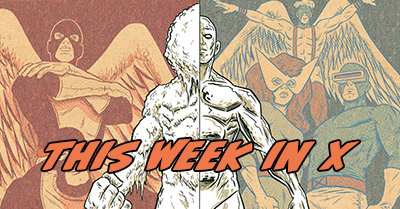 I’m finally caught up to Marvel’s present day after a long abstention after Secret Wars, and that means I’m keeping up with the status quo of my favorite mutants for the first time since 2015. And, since I’m keeping up, why shouldn’t you, too?!
I’m finally caught up to Marvel’s present day after a long abstention after Secret Wars, and that means I’m keeping up with the status quo of my favorite mutants for the first time since 2015. And, since I’m keeping up, why shouldn’t you, too?!
This is a pilot of my new weekly recap of what’s new in X-Men comics. These are quick hit reviews, not feature-length write-ups or extensive recaps. My hope is that they’ll help you figure out the right books to be buying, and how to catch up with the current status quo of each title.
This weeks line-up is Astonishing X-Men (2017) #7, Iceman (2017) #9, Phoenix Resurrection: The Return of Jean Grey (2018) #3, Rogue & Gambit (2018) #1, X-Men: Gold (2017) #18, and X-Men: Grand Design (2018) #2.
Is this helping you decide what to buy or catch up with the present? Let me know in a comment! But, beware: spoilers abound!
![]()
Astonishing X-Men (2017) #7 
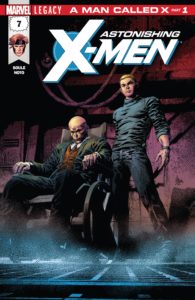
Cover by Mike Deodato, Jr. & Frank Martin, Jr.
Written by Charles D. Soule with artwork by Phil Noto and letters by Clayton Cowles. Cover by Mike Deodato, Jr. with colors by and Frank Martin, Jr.
Most-recent place to start: Issue #1
The story so far: The Shadow King pitted himself against Charles’s Xavier’s disembodied psyche for control of the Astral Plane and perhaps the entire Earth. A small cast of X-Men joined him in battle, and using the malleable psyches of Rogue and Mystique Xavier managed to catch the King off guard long enough to K.O. him. But, how will Xavier manifest himself back in the physical world?
This week: This is a slow-moving issue that’s chiefly concerned with resolving all of the little bits of cliffhanger that writer Charles Soule left dangling last month as well as setting up the next conflict. It’s a thrill to see Phil Noto back from Star Wars, especially on an X-book, but he may have been wasted on an issue that mostly tread water in the story department.
I feel like Soule is lingering on a lot of unnecessary scenes in this book. It’s not the first time I’ve felt that way on this series. It’s not that it seems decompressed, but that it feels like we’re spending a lot of time with some of the more inconsequential moments of this cast – ones we could have easily inferred to have happened between other, more-interesting panels. At first I gave him the benefit of the doubt that they would have future payoffs, but that doesn’t seem to have been the cast in the first arc.
This comic feels feather-weight compared to the weighty epic we were promised at the start, and I’m not convinced Soule can elevate it back to the fever pitch he had coming out of issue #1 now that we have the big reveal of Xavier back in the corporeal world.
![]()
Iceman (2017) #9 
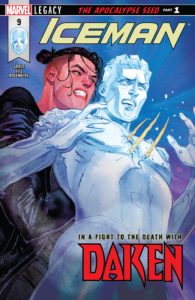
Cover by Kevin Wada
Written by Sina Grace with pencils by Robert Gill, inks by Gill with Ed Tadeo, colors by Rachelle Rosenberg, and letters by Joe Sabino. Cover by Kevin Wada.
Most-recent place to start: #5 or 6
The story so far: Bobby Drake has finally accepted that he is gay (via Jean Grey outing his time-displaced younger version), but now he has to break the news to the rest of the world. He reestablishes an uneasy friendship with former flame Kitty Pryde as they retrieve a new mutant, only to have him later scooped out from under their noses by a meddling Daken. Bobby eventually comes out to his always-overbearing parents before heading to the West Coast to mourn a fallen former teammate with his compatriots from The Champions. In the process, he picks up his first boyfriend.
The week: Here’s the one nice thing I can say about this Sina Grace Iceman issue: it has finally found the right art team with Robert Gill (w/some inks from Ed Tadeo) and colorist Rachelle Rosenberg.
Writer Sina Grace is fresh off two energizing issues in LA and his best issue yet with a Drake family dinner, which is maybe why this one was such a letdown for me. It’s not the plot that bothers me. I totally buy Iceman moving fast to move across the country to be with his boyfriend – it’s pretty consistent with his capricious character! It’s that Grace simply writes the domestic and fish-out-of-water scenes in this book better than the X-ensemble scenes.
A lot better. All the best issues of this book have been away from the X-Men! Here’s, he’s drowning in the midst of them, including a lengthy shopping scene with Idie and Michaela that feels completely unnecessary.
One of the most enjoyable featured Bobby tangling with a deliciously wicked Daken (one of my favorites). Daken is back here, but he seems unnecessarily manic. It seems like there could be a good story hook for his behavior, but it made for a messy read – made all the more annoying by Daken casually cornering an entire mansion full of X-Men and students.
I’ve really come around on this book thanks to the past three issues, but I wish Sina would stick to smaller slice-of-life issues that happen to have superheroism in them.
![]()
Phoenix Resurrection: The Return of Jean Grey (2018) #2 
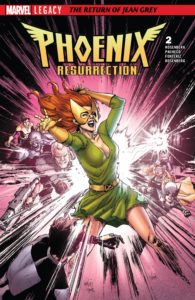
Cover by Leinil Francis Yu and Rachelle Rosenberg
Written by Matthew Rosenberg with pencils by Carlos Pacheco, inks by Rafael Fonteriz, colors by Rachelle Rosenberg, and letters by Travis Lanham. Cover by Leinil Francis Yu with colors by Rachelle Rosenberg.
Most-recent place to start: Last week’s #1
The story so far: Strange psychic phenomena around the globe are triggering Cerebro and presenting the X-Men with brief fights against classic foes. Meanwhile, we see Jean Grey living a seemingly pedestrian life as a diner waitress in a reality full of X-Men who have died.
The week: This serving from writer Matt Rosenberg is kind of a big old nothing-burger compared to the stunning first issue. We spend a lot more time with the parallel reality Jean here than we did last time, and a lot less time with the gradual increase of dread in the real world.
It’s a fun tease, but it’s not real, really satisfying Jean Grey. It’s just a character in the shape of Jean living a plain-jane life, which is hard to reconcile with a born leader with a post-graduate degree. Obviously there are some glitches in this fabricated reality, but I question if this Normaltown existence is really a thing Jean would conjure for herself or a thing that could effectively imprison her. (My bet is on it being a world her psyche has built in the White Hot Room).
Back in the real world, Rosenberg uses all of the X-characters we’ve been seeing lately, plus two delightful teams of his own design. The one that sees the most action is adult Iceman, X-23, Chamber, Longshot, Boom Boom, and Hellion – totally weird, but I love it. Then, the “Black” squad, featuring Dazzler, Pixie, Strong Guy, and Shatterstar. Where is that comic book?!
It’s combinations like that which prove Rosenberg to be a real fan of the franchise (as does Cable’s flameout in using Cerebro). I’m not usually a fan of penciller Carlos Pacheco, whose characters can come off a bit wooden, but there they’re all quite supple thanks in large part to Rachelle Rosenberg’s colors.
![]()
Rogue & Gambit (2018) #1 
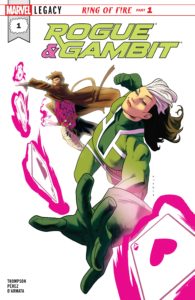
Cover by Kris Anka
Written by Kelly Thompson with line art by Pere Perez, color art by Frank D’Armata, and letters by Joe Caramagna. Cover by Kris Anka.
Most-recent place to start: Right here!
The story so far: Rogue has been away from the X-Men franchise (except for in Astonishing X-Men) leading the Uncanny Avengers, where Wonder Man was pulled out of her psyche and she had a brief romantic dalliance with Deadpool, of all people. Gambit has been AWOL from the teams, back to being a thief per his recent appearance in X-Men: Gold.
This week: This was easily my most-anticipated book of the week – a titled turn from my favorite X-Man with her 90s sparring partner, written by the always-witty Kelly Thompson.
Maybe I built it up a bit too much. This was not a shock-and-awe sort of first issue, but a relaxed one. There’s no punching outside of the Danger Room. In fact, I think some cynical editors might even brand it as a #0 issue, as it’s much more about establishing the table stakes of this story than getting deep into the story itself.
Even if this is mostly set-up, it was a relief to hear everyone written on-voice and with respect to continuity – especially Rogue. So many writers seem happy to put split-personality Rogue behind them and simply have get go through the motions as the “tough, experienced lady” without really digging into the vulnerability she has subsumed along the way.
Thompson rejects that, writing Rogue as a strong-willed leader who remains unsure of her place in the X-Men and with Gambit. It doesn’t help that Gambit won’t stop pestering her. He’s in full on Pepé le Pew mode here, visiting the mansion thinking he might bother “Stormy” for the day before shifting his attention to Rogue. I don’t know that Thompson has his voice as perfected as Rogue, but I enjoyed how he helplessly optimistic about Kitty’s leadership abilities because he can’t be bothered to think about it much more deeply.
Pere Perez draws a slightly less-muscled Rogue with a nod to Anna Paquin’s willow-y version, as opposed to the sparkplug we often see in Uncanny Avengers. His in-costume Gambit is great, but out of it he has a generic Scott Summers look to him. I love how colorist D’Armata handles lighting effects, but on the whole I think the colors on this book are slightly too bright in a very 10-year-ago sort of way. They remind me of Messiah Complex era X-Men. I think something a little subtler might have brought out the detail in Perez’s art a bit more.
Also, what a horrific cover from noted anatomy abuser Kris Anka (though his coloring is awesome).
![]()
X-Men: Gold (2017) #18 
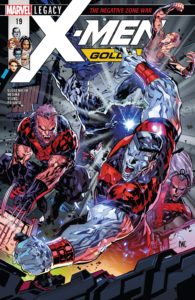
Cover by Ken Lashley and Federico Blee.
Written by Marc Guggenheim with pencils by Diego Bernard, inks by J.P. Mayer, colors by Chris Sotomayor, and letters by Cory Petit. Cover by Ken Lashley and Federico Blee.
Most-recent place to start: Issue #16 was the beginning of this “Negative Zone War” arc.
The story so far: The X-Men have been holding captive a peculiar alien from the new incarnation of the Brotherhood of Evil Mutants ever since the first arc of this title. A ship from the Negative Zone breaks through to our dimension to retrieve the alien, the leader of a revolution on their home world. In defending Central Park against the ship, Nightcrawler and Kitty wind up aboard while it retreats to the Negative Zone, leaving Storm, Colossus, Old Man Logan, Rachel Summers, Armor, and Ink to pursue them. They wind up meeting the opposite side of the rebellion, and might have gotten Kitty and Nightcrawler back home without an issue if an ancient god hadn’t awoken to insert himself into the conflict.
This week: Let’s just get this out of the way early: I think X-Men: Gold is a horrible comic book and you should not be reading it.
It’s nice to have the X-Men on an adventure out of their comfort zone that’s not about being hated and feared. Even if it’s in an alternate dimension, at least it’s not one stocked with dozens of copies of X-Men characters!
It’s a step in the right direction to get the X-Men back to being heroes in a plot that’s not all about their extinction, but the next step has to be leveraging those stories for us to get to know the characters better and for them to act as their true selves.
No one’s really living up to that here, in a comic where seemingly everyone is interchangeable save for their powers. Aside from a brief moment of confident leadership from Colossus, it feels like the team could be speaking as a single Greek Chorus, their dialog is so bland and impersonal. Guggenheim has brought his pet character Ink to the fore in this plot, but we haven’t learned a single thing about him other than that his name is Eric. Armor is back on an away squad and interacting with Old Man Logan, but we get nothing.
That said, I have to give credit where it’s due that this is an improvement over the past few issues. The book has a more solid, polished look to it than the messy prior chapters, and their teamwork to take down the mountainous god feels like a very old-school, by-the-numbers X-Men adventure. It’s just missing the characterization that came with this great, classic comics.
![]()
X-Men: Grand Design (2018) #2 
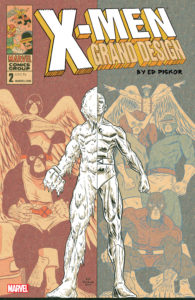
Cover (and everything inside!) by Ed Piskor.
Created by Ed Piskor. Edited by Chris Robinson and Mark Paniccia.
Most-recent place to start: You can read this comic on its own.
The story so far: Issue #1 recapped the X-Men from before Xavier’s birth to their first issue in 1963 as witnessed by The Watcher. It pulled together disparate retconned plot threads that you’d be hard-pressed to have read all of, along the way emphasizing the undercurrent of the Phoenix Force seeking its next host on Earth.
This Week: This issue is a torrid recap of X-Men issues #1-66 in 42 pages – essentially, a page per story of the entire classic run of X-Men.
I’m not sure I could ever again recommend anyone spend their time reading those issues when they could read this comic instead.
Ed Piskor adapts his style to the Silver Age, drawing some remarkably great panels of the X-Men’s early adventures (his Magneto is wonderful!) and making it seem like they were all part of a single 66-issue plot rather than a bunch of disparate stories struggling to match the popularity of The Avengers and The Fantastic Four.
At the same time, reading this makes me want to read those original comics – both to re-experience these stories and to see where Piskor has worked some subtle magic to make them seem more interesting and interconnected.
It will be six months before we get to see his take on Claremont’s era of Uncanny X-Men, where everything actually was connected the entire time. I’m intrigued to see if he can work as much transformative magic in summarizing those stories, or if it will feel like a paler echo of strong material.